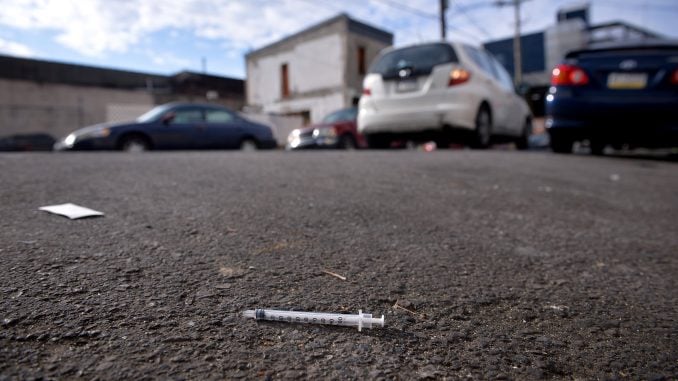
RALEIGH — As North Carolina reels from its worst year of opioid overdoses in history in 2017, 2018 data is still being compiled and analyzed to determine if progress was made. Two drugs that were not well-known by the public until recently, are impacting the overdose epidemic — fentanyl, a powerful synthetic opioid which has spiked the number of deaths, and naloxone, an opioid agonist that can reverse overdoses which is being credited with saving lives.
According to the CDC, “Fentanyl is a synthetic (man-made) opioid 50 times more potent than heroin and 100 times more potent than morphine.”
Since the boom in illegally manufactured fentanyl hitting the streets, overdose deaths in North Carolina related to the drug went from 543 in 2016 to 1246 in 2017, more than doubling in a single year.
Robert Childs, former director of the N.C. Harm Reduction Coalition, which plays a leading role in combating the overdose epidemic, told North State Journal, “The big issue is fentanyl is now in drugs where they are not expecting it. It’s like getting a glass of beer, but it’s actually filled with 100 shots of whiskey. We know, at the Harm Reduction Coalition, there’s a large amount of fentanyl in the North Carolina drug supply leading to an increase in overdose incidents. 2017 was pretty intense. The death data jumped significantly, largely due to synthetic fentanyl. Fentanyl has been around, but not this much and for this cheap.”
Fayetteville Police Captain Lars Paul calls it “an everchanging monster.”
“We’ve seen a steady increase in opioids in general, and over the last couple years it’s evolved from pills, to fake pills, to now more and more fentanyl.” Paul told NSJ. “They’ll add it [fentanyl] in with heroin to make it more potent, or with unrelated drugs like cocaine or methamphetamines, or in some cases, it’ll just be fentanyl by itself, with a cutting agent.”
Waynesville, in the mountains, has also been hard hit, showing the geographic diversity of the problem. Chief Bill Hollingshead told NSJ, “When you look at per capita usage and per capita overdose death, we’re pretty high up on the list. We first noticed it about 11 years ago, when about one in four deaths in the county was due to opioid overdose. Which is incredible considering all the various causes of death the medical examiner can come back with.”
It is not just Waynesville or Fayetteville or North Carolina that is dealing with high death rates. Opioid overdose is now the No. 1 preventable cause of death in the entire United States, topping gun deaths and even car accidents.
“Since the advent of the automobile, car accidents were always the number one cause of death in the country, but two years ago, opioid overdose overtook that number,” said Chief Hollingshead.
With over 70,000 dead in 2017 alone, law enforcement and first responders often feel they are not equipped to win this war.
Asked if he sees any hope on the horizon to reverse these catastrophic numbers, Paul said, “Do I see any hope, honestly? Of defeating the opioid epidemic, right now? Not really. We’re just trying to keep it from getting worse. We’re doing what we can to keep people alive, we’ve got some programs, but until the whole country mobilizes and does something to treat it as the crisis that it really is, we’re just piecemealing it. If we had over 70,000 dying in a year from Ebola, we’d have field hospitals in every city.”
One thing that is having an impact on the numbers though, is naloxone, also called by the brand name Narcan. This injectable opioid agonist quickly reverses overdoses and is responsible for thousands of people surviving lethal doses of fentanyl.
“Ever since 2015, we’ve had officers carry naloxone, and we’ve saved 170 lives with it since that point, and that’s just the Fayetteville Police Department,” Paul said. “Our reversals are steady, not any better, probably a little bit worse even. Addicts are reversing each other with naloxone. Common practice is they almost have to carry it with them because there is so much fentanyl.”
As to whether naloxone had enough impact to bring the final 2018 numbers below 2017’s, Paul isn’t sure. “Deaths aren’t going down, but if it wasn’t for the huge amounts of naloxone given out by groups like Harm Reduction, there would be even more deaths. It would be a lot worse — absolutely catastrophic.”
In Waynesville though, Chief Hollingshead believes there was a minor dip in deaths and that naloxone was the reason. “The dealers are actually giving our undercover officers naloxone with the purchase. 2018 looks like it may end up being a slightly better year than 2017, although it goes in waves, with a couple bad months for overdoses and then some improvement. I attribute this to law enforcement, but also to the wider availability of naloxone.”
Both Paul and Hollingshead said they don’t believe drug use or overdoses have gone down, but the deaths from overdoses at least are being mitigated by naloxone. If use remains high, some worry reversing an overdose is only delaying, rather than preventing deaths. Treating dependence and preventing initial abuse are also part of preventing the spiraling of overdose deaths.
The STOP Act, a bipartisan bill signed by Gov. Roy Cooper June 29, 2017, passed 118-0 in the House and 50-0 in the Senate. The bill focused on strengthening regulation around the prescribing of opioids and also making opioid agonists, like naloxone, more available and less regulated.
Chief Hollingshead said he believes the STOP Act did a lot to prevent overprescribing, but many of the addicts simply moved to heroin, which is now contaminated by fentanyl. He’s sees a major part of the problem as the high relapse rate, which calls for more research and better treatment programs.
“It is a very difficult addiction to recover from. It is not a 30, 60, 90-day, even a 6-month long program,” Hollingshead said. “It is a long term, likely a lifelong commitment to opioid recovery. And we’re seeing that time after time, we’ve had people that have been addicted to cocaine, even methamphetamines, in the past, who say that addiction is nothing compared to an opioid addiction. Your body just has to have the drug.”
“There is a high relapse rate,” Captain Paul agreed. “It’s almost a given that they’re going to relapse at some point.”
Paul and his department offer the “LEAD Program,” which stands for Law Enforcement Assisted Diversion, a program that diverts low-level drug crimes through volunteer treatment. Even with these measures, Paul admits he’s only seen a handful of participants really be able to completely leave drugs behind. Treatment programs that are realistic about these likely setbacks, he believes, are more likely to see success.
Despite the continuation of high levels of opioid use and overdose, later this year the numbers will reveal if wider availability of naloxone has brought the death numbers down, or if the flood of cheap, powerful fentanyl was too much to combat using current strategies.



